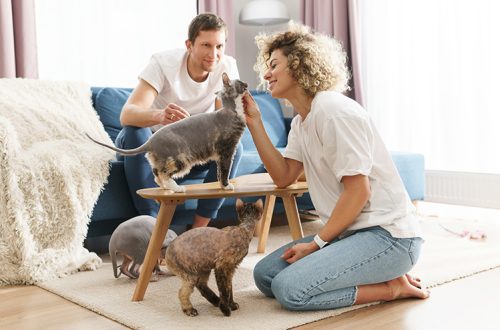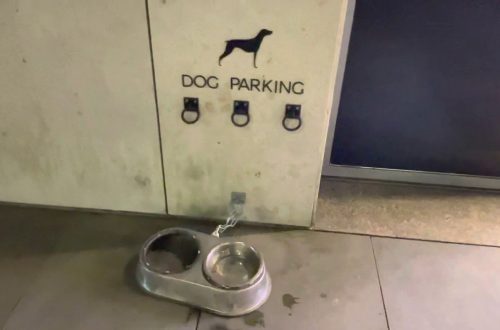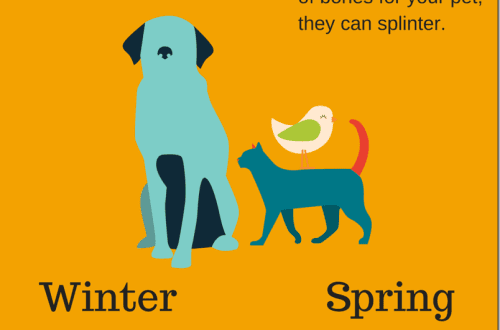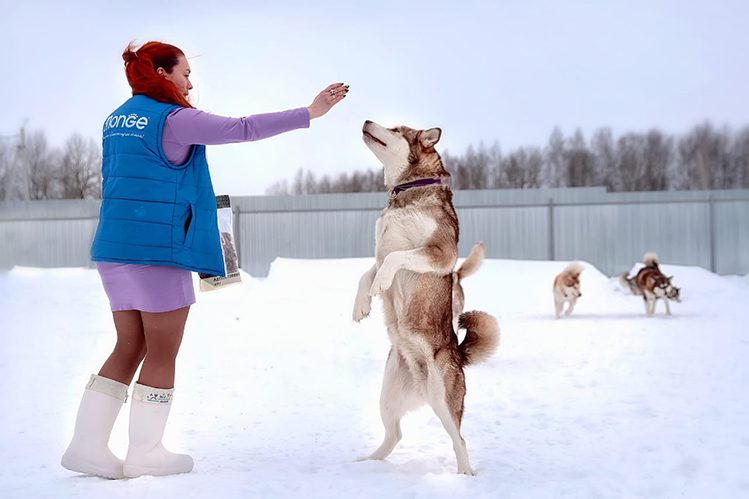
Šunų rogės: viskas, ką norėjote žinoti
Have you been lucky enough to ride a dog sled at least once in your life? If not, you need to fix it ASAP! Just imagine: real sleds, speed, adrenaline, and most importantly, you are driven not by a soulless engine, but by a well-coordinated team of man’s best friends! Impressive?
But what if you manage the team yourself? Ride not only in winter on sleds, but also in summer on a scooter? Participate in competitions and win top prizes? What if racing becomes your hobby and even your profession?
This is exactly what happened with Kira Zaretskaya – An athlete, sled dog trainer and breeder of Alaskan Malamutes. How did it happen? What is sledding in Russia? Can an ordinary person with zero experience start doing it? Find out in the interview. Go!
- Kira, tell us about your activities. How did you decide to open a kennel and develop sledding? Many of our readers probably did not even know that such a sport exists.
It all started with sports. Later I became a breeder and opened a cattery. My inspiration was my first dog, Helga, an Alaskan Malamute. She solidified my love for the breed and led me into the world of sledding.
In my view, the owner and the dog must have some kind of joint activity. The dog should have its own work, its own business, in which it will realize itself and enjoy it. It can be dancing with dogs, agility, search work and much more that your team will like. For us, sledding has become such an occupation.

— How often are sledding competitions held in our country?
There are quite a few competitions right now. Every weekend in Russia there are several races of different ranks in different regions.
– When you hear about a dog sled, you imagine a snowy winter and a sleigh. What about summer training? Is there an alternative to a snowy field.
Of course! Sledding is not only sledding in the snow. Everything is much more interesting!
In spring and autumn, you can train on a bicycle, a scooter (a large scooter), a go-kart (it’s something like a three- or four-wheeled scooter) and, of course, just running with a dog (“canicross”). All this must be done exclusively on dirt paths, at a temperature not higher than +15.
– A list of your awards has been published on the site. It really is endless! What are the most valuable achievements for you?
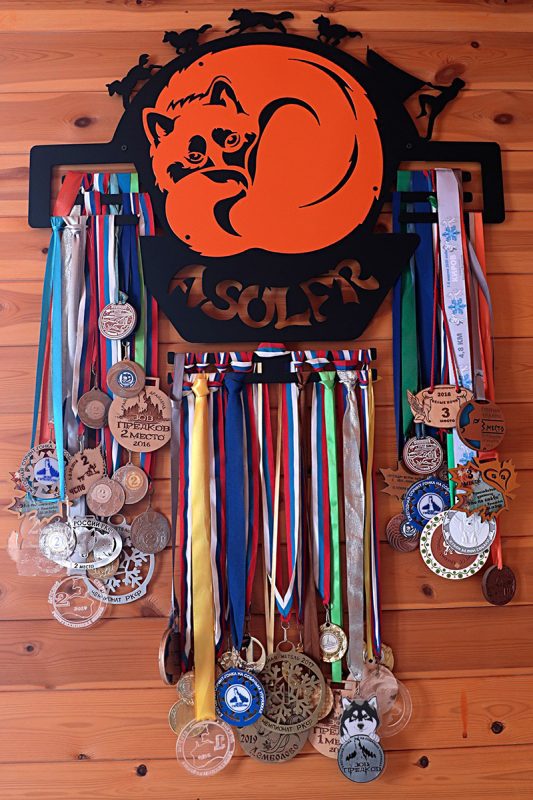 From the main: I am a multiple winner and prize-winner of the races of the Russian and International level. I am a member of the Russian National Team in WSA, I have the 1st category in Sledding Sports.
From the main: I am a multiple winner and prize-winner of the races of the Russian and International level. I am a member of the Russian National Team in WSA, I have the 1st category in Sledding Sports.
My dogs took prizes at Ryazan Open Spaces, Christmas Hills, Call of the Ancestors, Night Race, Moscow Region Championship, Snow Blizzard, Kulikovo Field and other championships in different years. At the Snow Blizzard 2019 race of the RKF Championship rank, they showed the best time among ALL “4 dogs” teams and the third result in the distance among “4 and 6 dogs” teams.
— Impressive! How did your first workouts start?
When Helga appeared in our family, we began to think about how to provide the right level of load for her. Malamute is a driving breed, and an inactive lifestyle is contraindicated for such a dog. We were faced with questions: where to run with a dog, how to start exercising, where to find people who will help and show?
At that time, there were few clubs involved in sledding. Now they are in almost every district of Moscow. And then we had to make a lot of efforts to find professionals.
At the age of about six months, Helga and I first visited the Snow Dogs Club. It was too early to train her, but to get acquainted and assess the situation – just right. Thanks to this trip, we learned about the preparatory work that we could start at home on walks on our own.
Already closer to the year we began serious training. I will not talk about the long path of trial and error, ups and downs: this is rather a topic for a separate interview. The main thing is that we did not retreat and now we are where we are!
— You started training with a Malamute. Tell me, do you need dogs of certain breeds for sledding? Or anyone can harness their pet and ride through the streets of the city?
There are no breed restrictions in sledding. Both shepherd dogs and royal poodles run in a team … I met a team of 4 Labradors, a chic team of Dobermans, a Jack Russell in canicross and skijoring … You can come to this sport with almost any breed, except for brachycephalic dogs: this activity is not suitable for them because for physiological features.
But I would not recommend driving through the streets of the city. Still, asphalt, paving stones are not the best surface for running. The dog is most likely to injure the paw pads and joints. It is better to train on the dirt paths of the parks.
And of course, the pet must be taught in advance the commands “Forward / Stand / Right / Left / Straight / Past”. Otherwise, your hobby will be traumatic for you and for others.
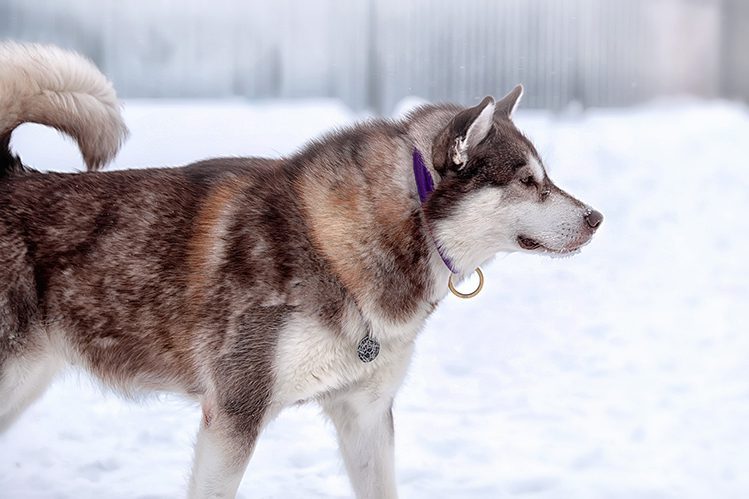
Kiek svorio gali tempti šuo?
It depends on many parameters: the breed of the dog, the number of dogs in the team, the length of the distance. For example, Siberian Huskies are great at handling light loads for sprints (short) distances, while Alaskan Malamutes are all about heavy weights and long (long) distances. Everything is very individual.
– How many dogs, minimum and maximum, can participate in a team?
There can be at least one dog in a team – such a discipline is called “canicross” or “skijoring”. At the same time, a person runs with a dog on his feet or on skis.
The maximum number of races is up to 16 dogs, if these are long distances, where from 20 to 50-60 kilometers are covered per day. There are no restrictions for expedition trips. The variety is quite large.
The most common are sprint (short) distances:
a team for one dog is skijoring in winter and canikros, bike 1 dog, scooter 1 dog in the snowless season;
two dogs – a sled 2 dogs, skijoring 2 dogs in winter and a scooter 2 dogs in the snowless season;
team for four dogs. In the winter version, this is a sled, in the summer version, a three- or four-wheeled kart;
team for six, eight dogs. In winter it is a sled, in summer it is a four-wheel cart.
Is it difficult to harness a dog to a harness?
Not difficult. It is necessary to put on a special harness (not a walking harness) on the dog and fasten it to a pull – a special leash with a shock absorber. Further variability of actions depends on the number of dogs. The larger the team, the more skills will be required from both the musher and the dogs, especially the leaders of the team.
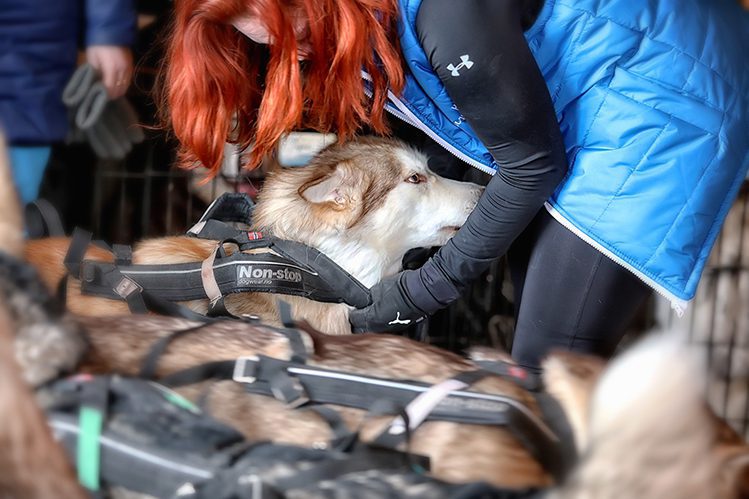
How are dogs taught to ride? At what age do they start running in a harness?
From childhood, dogs are taught working teams for a team along with regular training. Everything is served gently and unobtrusively in a playful way, during a walk. A year or a little later, dogs begin to learn to work in a harness. At first, these are small distances of 200-300 meters. Ideally, these are two people: one runs with the dog (the dog runs ahead and preferably pulls), the second person at the “Finish” joyfully calls the dog, praises and gives a treat when the dog runs up to him.
Now sledding is becoming more and more popular. There are many detailed articles on the Internet with step-by-step instructions: what to do and how to do it. Valuable recommendations can be found in the group of our cattery on the hashtag #asolfr_sport. There and about training, and about nutrition, and about care, and many other nuances. Unfortunately, there were no such articles before. For Russia, this is still a very young sport.
Question about nutrition and care. Do sled dogs need any special toys, food or treats?
On this topic, one could give a separate interview or write a long article, but I will try to tell briefly.
We choose toys that are safe and durable. The ones that won’t do any harm even if the dog accidentally bites off a piece and swallows it. Malamutes have very strong jaws, and ordinary toys are not enough for them even for an hour. Therefore, we mainly buy anti-vandal toys KONG, West Paw and PitchDog. They live with us for years, and delight dogs. Some toys can be filled with treats. They mercilessly chew and gnaw, but they hold on perfectly!
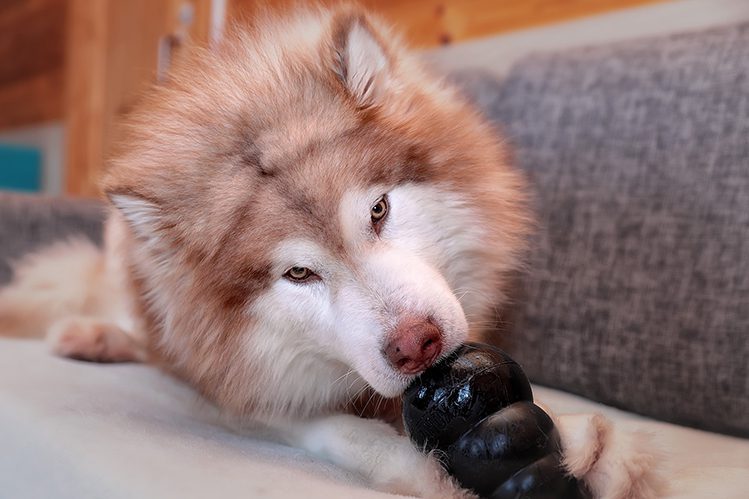
Treats are indispensable in training. We choose the most natural ones: most often these are dried or dried pieces that are convenient to store and carry with you.
Throughout my pack, I often indulge in Mnyams treats after training, this is a great encouragement. Especially if you are not ready to bother with cooking. I also love making my own treats for dogs.
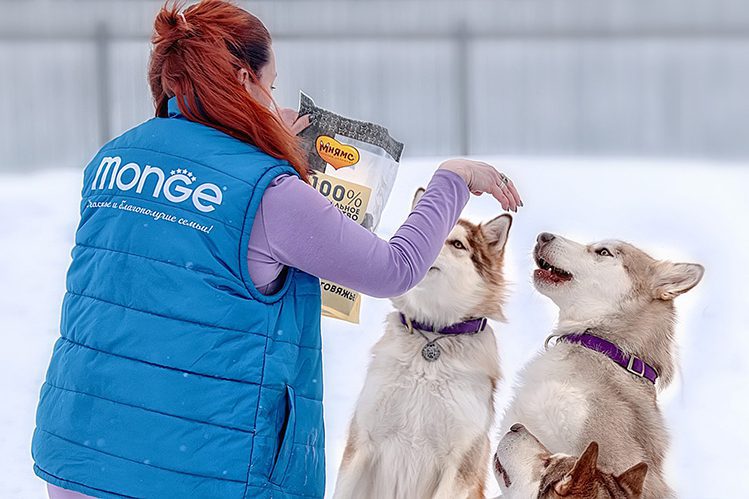
The nutrition of any dog should be complete and balanced, and sports – even more so! In the feed, high-quality protein and its sufficient volume, the correct balance of fats, minerals, micro and macro elements and specific nutrients (antioxidants, vitamins) are important. This balance is difficult to achieve on your own at home, so ready-made balanced feeds are the best solution.
Contrary to common misconception, a dog does not require variety in its diet. In fact, they have poor taste discrimination and perceive food more due to their keen sense of smell. But what dogs really appreciate is stability. That is, the same diet in the same bowl, in the same place, at the same time. And so every day! If the food is chosen correctly, there is no need to change something in the diet. On the contrary, experiments are the path to digestive disorders.
When choosing food, you need to take into account the individual characteristics and needs of the dog (state of health, lifestyle, pregnancy and lactation, growth period, participation in sports). It is better to choose a brand that offers a large selection of food for different dogs at different periods of life: we settled on Monge.
In sports dogs, the need for protein increases. Regular physical activity, high nervous tension during competitions – all this speeds up protein metabolism and increases the body’s need for protein by almost 2 times.
What accessories does a dog need for sledding?
The base set is:
Riding harness. It is purchased at a specialized store or sewn to order. You should not take a harness for growth: if it does not “sit” on your dog, balance is lost and the load is distributed incorrectly. This can lead to sprains, spinal injuries and other bad consequences.
Pull or cord. You can make it yourself or buy it in a specialized store. For pulling, it is better to choose bronze carabiners: they freeze less in winter and are safer.
shock absorber. An important thing, especially when working with young or inexperienced dogs. Some fundamentally do not use traction with a shock absorber. But I assure you, this accessory will help to avoid injury to the pet. It stretches during the snatch without overloading the spinal column.
– Any person from the street can come to sledding? Or do you still need experience, certain skills?
Anyone can start riding. Initially, no skills are needed. Only desire and time! For the rest, there is now a mass of literature and specialized clubs where they will help you.
— What if I want to go in for sledding, but I don’t have my own dog? Or if there is a dog, but this direction does not suit her?
You can come to sledding without your dog. Usually they come to a club where there are dogs, they train young mushers there. We can say that you “rent” a dog for training and performances from the club. Not the best, in my opinion, option for sports. But for the initial stage it is very useful. So you will understand whether you need it or not.
– It turns out that there are special courses where they teach sledding?
Yes. Most often these are online courses. There are courses with visits, for example, in St. Petersburg and some other cities. Most often, training takes place in sledding clubs or nurseries specializing in sledding. In a good club, they are happy to help, support, tell.
There is still little methodological material on this discipline. The main value is the experience of the trainer, his understanding of dogs (others and his own), knowledge of breeding lines. All pets are individuals. To teach dogs to work well in a team, you need to pick up the key to each of them. A good coach knows how to do this and can teach you a lot.
— If a person dreams of going in for sledding, where should he start?
To begin with, read about this sport, come to the competition as a spectator, and communicate with the participants. Pick up a club or nursery to try to work out and understand whether it is necessary or not.
Driving sport is a very beautiful picture. But behind the scenes there is a lot of work and labor that beginners may not be aware of.
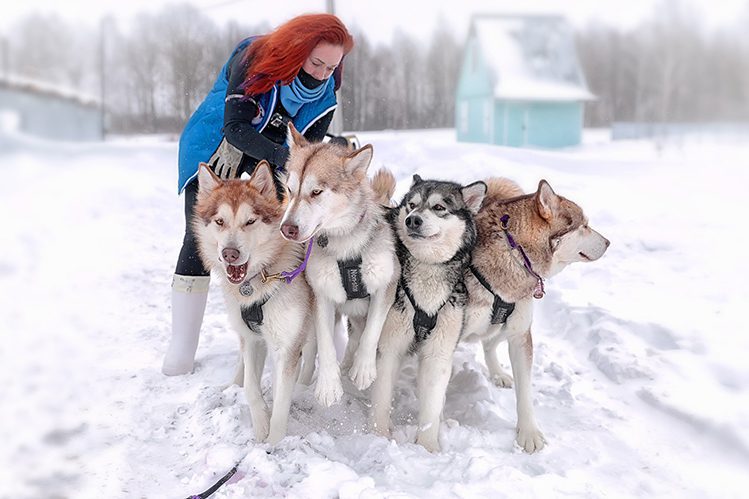
— What are the main risks and difficulties in this area?
The risks and difficulties for each, of course, their own. First of all, you need to be prepared for decent time and material costs, for full return. Others will not understand you: why waste money, time and effort on something that does not bring income?
We are often asked if our prize money pays off. No, they don’t pay off. Firstly, in Russia we have a few races with a cash prize fund. But even they do not pay for the transportation of dogs, accommodation and meals for the musher and assistant on the road, equipment: sleds, skids, harnesses and other related accessories. You will never come out in a plus on the races.
But the most dangerous risk is, of course, injuries in competitions. Both dogs and mushers can get them. The most common injuries in our field are fractures of the collarbone and injuries to the arms and legs of varying degrees. Luckily, I didn’t break anything, but I had sprained ligaments and broken joints several times. No one is immune from sports injuries.
— Can you tell us about your most memorable race?
My most memorable race is probably the first one. There were a lot of races, they are all very different and you can talk about a lot. But still the most memorable is the first one, when you go to the distance for the first time and everything is new to you.
My first race was skijoring (ski track), SKP race in Butovo. I practically don’t know how to ski and climb hills badly, and then I didn’t know how to do it at all!
It so happened that we were training the “two dogs” sled and at the last moment my dog’s partner could not leave. We had to change the discipline when there were only a few days left before the competition. And I, at my own peril and risk, went out in skijoring (on skis).
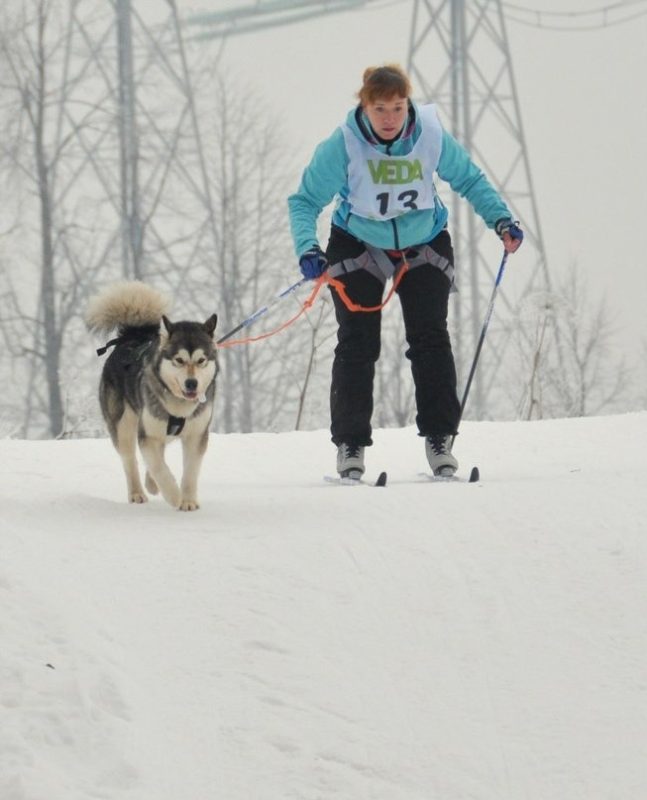 There are few photographs from that race. But there is a very cool photo where my Malamute Helga and I stand on the first hill and look at the descent. Anyone who has been on the ski run in Butovo knows that there are sharp descents and sharp ascents. I have indescribable horror in my eyes. I knew that I would somehow succeed in going down, but it would be almost impossible to go up. And the distance was 3 kilometers!
There are few photographs from that race. But there is a very cool photo where my Malamute Helga and I stand on the first hill and look at the descent. Anyone who has been on the ski run in Butovo knows that there are sharp descents and sharp ascents. I have indescribable horror in my eyes. I knew that I would somehow succeed in going down, but it would be almost impossible to go up. And the distance was 3 kilometers!
At our own peril and risk, we went down from the first hill, but I went up the hill on all fours! At the same time, I forgot to put on gloves, as I was nervous before the start. I climbed with my bare hands, on my knees, crawling, because I couldn’t drive up the hill. So we went absolutely all the slides! I went down, we flew halfway up the ascent, I fell on all fours, clinging my fingers to the height to which we could fly, and then crawled on all fours. Imagine what a sight it was!
A couple of times I flew off these slides, fell and hit my chest so that the air was knocked out. Before the finish, my dog even started to slow down, look back, worrying that I was about to fall and I would be hurt again. But despite this, we finished, we made it!
It was definitely an adventure. I understood that I let the dog down, that I entered the competition on the track with slides without learning how to climb them. However, we did it! It was an invaluable experience.
Later, I had another ski competition, where we finished last. In general, I did not work out with skis. But I keep learning them. Now I’m trying to learn how to skate in them, but more in a format for myself.
– Kira, how can a person understand where the line is between a hobby and a calling? When to do “for yourself”, and when to move to a new level? Go to competitions, for example?
There is no such clear line where a hobby develops into something serious. You always decide for yourself what result you are striving for at a particular time.
I think you should always go to competitions. Even if he just started. Of course, you first need to learn the rules and get along with the training dog. But you definitely need to go out to understand how ready you are for this sport.
The psychological and physical load in competitions is very different from the load in training. No matter how active the training is, it is always more difficult in competitions. But you should not be afraid. In sledding there is a special discipline for beginners Happy dog. This is an easy short run. It usually involves young athletes with young inexperienced or older dogs. If this is the dog’s first competition, not only a beginner can run with it, but also an experienced trainer. So the dog is taken out into the world, tested, see what are the nuances, what needs to be worked out before exhibiting in the main discipline. All this is very interesting!
How can an athlete become a coach? What is needed for this?
Need experience and understanding of dogs. Experience is gained over the years when faced with different situations and working with many dogs. The more dogs you trained, the more knowledge you gained.
Not every dog is born to be fast, but all dogs can run for fun. It is important for the trainer to understand the capabilities and limits of his ward, so as not to demand excessively and not to suppress the dog psychologically.
And it is also important to understand the anatomy, physiology, features of digestion, the needs of the dog as a whole. You need to be able to stretch, massage, take a walk, warm up or, conversely, give it a rest. All this is experience.
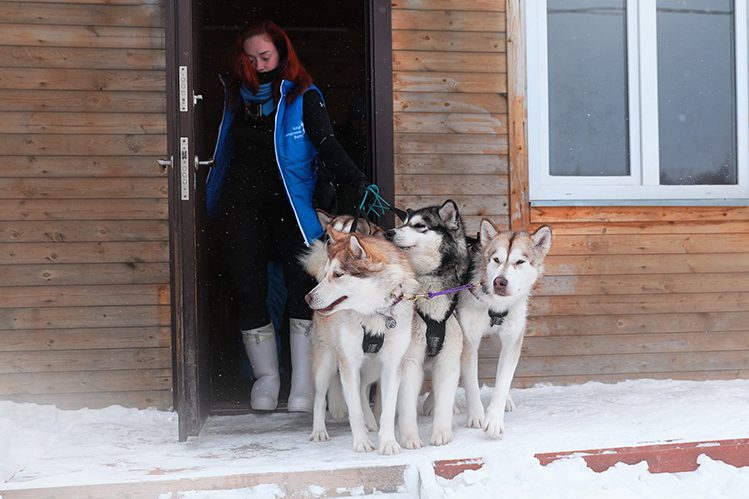
— Kira, thank you so much for the wonderful conversation! Would you like to say something as a conclusion?
I would like to express my gratitude to the people who are important to me:
to his mentor at the beginning of the journey Esipova Kristina. Kuznetsova Elena for great moral support
to the owners of Jessica, Helga’s first partner, Alexander and Svetlana. With Svetlana, we went to the first races in the 2 dogs team class and took one of the most valuable awards for me, Lantern of the Last Musher. To this day, it stands on a par with the most significant and beloved victory cups.
to all close people who support at competitions and races, to everyone who goes to the races as mushers of the 2nd and 3rd composition, this is often a non-trivial experiment.
to the whole team of the Asolfr kennel. To everyone who was part of the Asolfre kennel team over the years and supported the development. I thank everyone who is now part of the Asolfr kennel team for their support and help, for covering the rear during away competitions. Without the support of the team, the kennel would not have achieved such results! Thank you!
Thank you very much my dear people! Without you, we would not be in this sport. Most likely, there would be no Asolfr nursery. You helped and supported us at the beginning of the journey, when it was incomprehensible, scary and I wanted to quit everything. I remember and appreciate it very much, despite the fact that now we rarely see each other.
It was my way to a dream, the romance of the north from childhood and books. At first, I dreamed of assembling a team of “4 dogs” from malamutes. Then not just 4k, but a very fast 4k. We had a lot of difficult training, directed sports selection and selection. Selection of dogs according to anatomy, character and many other parameters… We studied a lot and continue to study: both me and dogs. And now, the dream has come true! She continues to come true even now. I sincerely wish the same for everyone!
And remember, the main thing that is required for sledding is desire.
Contacts of the nursery “Asolfr”:





